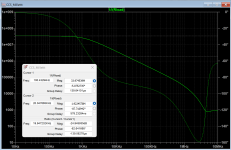DN2540 can be TO92 then?I cascode DN2540s with IXYS 10M90S as upper device and get great results. Edges are very fast with no overshoot. Other upper devices have given significant ringing on fast edges. That's my measurement experience.
Has anyone ever AB compared CCS with bootstrap (like a source follower bootstrapping the previous stage load through a capacitor)?
I'm interested in having some feedback from other people.
Has anyone ever AB compared CCS with bootstrap (like a source follower bootstrapping the previous stage load through a capacitor)?
I'm interested in having some feedback from other people.
Will be a good experiment!
Do you mean SRPP?DN2540 can be TO92 then?
Has anyone ever AB compared CCS with bootstrap (like a source follower bootstrapping the previous stage load through a capacitor)?
I'm interested in having some feedback from other people.
I did that in Ultimator headphone amp output. MOSFET can be viewed as a cathode follower loaded on a tube that it bootstraps.
The TO-92 version max dissipation is only 1W and thermal resistance 132 degrees C per Watt, the TO-220 version is 15W and 29 degrees C per Watt
I mean like this one:Do you mean SRPP?
The first stage is a pentode (driven by its cathode through a source follower) driving the source follower of the output stage. C2 bootstraps the load of the driver pentode.
https://www.diyaudio.com/community/attachments/1738192964386-png.1414710/
Yes, but the bottom part will only manage a few volts, so that’s fine.The TO-92 version max dissipation is only 1W
I've never done it, because I bought a bunch of the TO-220 ones, but it seems like a smart idea since there are only a few volts across the bottom device.DN2540 can be TO92 then?
Yes, note that SY in "His Master's Noise" used a pair of DN2540 -- but the bottom device could have been the TO-92 version as the input stage managed only 8mA.Yes, but the bottom part will only manage a few volts, so that’s fine.
In any event the impedance of the DMOS CCS is impressive.
Looks like the IXYS part as the top mosfet is the better choice than the DNs for modern cascoded CCS designs.
Ale does a great job here and surveys most good parts and current ratings for CCS devices.
https://www.bartola.co.uk/valves/for-sale/ccs-pcb/
Bartola ccs seems essentially identical to Pete Millet design.
For the price, the Pete Millet boards are 'goated'!
Ale does a great job here and surveys most good parts and current ratings for CCS devices.
https://www.bartola.co.uk/valves/for-sale/ccs-pcb/
Bartola ccs seems essentially identical to Pete Millet design.
For the price, the Pete Millet boards are 'goated'!

The same chip is in both TO-92 and TO-220 cases. You just get more power dissipation capability in the TO-220 size.I've never done it, because I bought a bunch of the TO-220 ones, but it seems like a smart idea since there are only a few volts across the bottom device.
I've searched on the forum and found this interesting thread, even if it's on SS devices:Has anyone ever AB compared CCS with bootstrap (like a source follower bootstrapping the previous stage load through a capacitor)?
I'm interested in having some feedback from other people.
Similar threads may have appeared here touching the subject of CCS versus Bootstrap configurations and I have simulated and build two identical amplifiers one using a CCS and the other a Bootstrap.
Interestingly enough the amplifiers overall performance is very similar, identical output, band width and overall THD.
However they sound remarkably different the amplifier using a bootstrap has a warmer and friendlier sound while the one with CCS has a more clinical and harsh sound.
Following is the amplifier with CCS, its band width and harmonic distortion at 1kHz, 10 kHz and 100 kHz.
Then...
Interestingly enough the amplifiers overall performance is very similar, identical output, band width and overall THD.
However they sound remarkably different the amplifier using a bootstrap has a warmer and friendlier sound while the one with CCS has a more clinical and harsh sound.
Following is the amplifier with CCS, its band width and harmonic distortion at 1kHz, 10 kHz and 100 kHz.
Then...
- U102324
- Replies: 84
- Forum: Solid State
Are there any mods needed to turn a top mosfet DN2540-based CCS into a IXYS-based one?
Something like 'his masters noise' CCS into an IXTP08N100D2 one?
Something like 'his masters noise' CCS into an IXTP08N100D2 one?
No modification required.
The cascode CCS behaviour -mainly- depends on the "lower" FET settings.
The cascode CCS behaviour -mainly- depends on the "lower" FET settings.
For "His Masters Noise" I would use a 10-turn potentiometer to get the precise resistor value for the current necessary (8mA?). Then get the closest value and solder in. In general, I don't like trimpots if there's going to be more than a few mA flowing through.Are there any mods needed to turn a top mosfet DN2540-based CCS into a IXYS-based one?
Something like 'his masters noise' CCS into an IXTP08N100D2 one?
- Home
- Amplifiers
- Tubes / Valves
- CCS IXTP08N100D2 sounds better than DN2540
